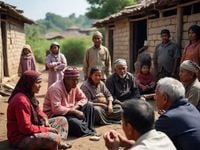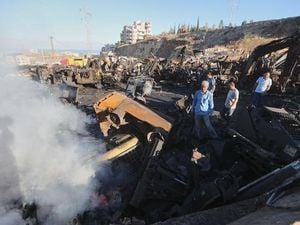As economic pressures mount across the globe, individuals and nations alike are searching for answers to persistent financial hardship and rising costs of living. In recent weeks, Adam Livingston, a prominent commentator on economic trends, has sounded the alarm on the state of the American economy, painting a picture many find all too familiar. Meanwhile, across Asia, millions grapple with another, harsher reality: extreme poverty fueled by war, instability, and underdevelopment. The contrast between these two economic landscapes reveals both shared anxieties and diverging paths toward financial security.
Livingston’s recent update, widely circulated on social media as of August 23, 2025, captures the frustration of many Americans facing sky-high prices for basic goods and services. He notes that starter homes now command a staggering $500,000 price tag, while the median wage lags far behind at $58,000. For those hoping to build a better future, the burden of substantial college debt only adds to the challenge. "With ribeye at $32.99 per pound and orange juice at $10, it’s no wonder people are feeling squeezed," Livingston observes, highlighting the inflationary pressures that have become a daily reality for many.
Perhaps most striking is his assertion that the presumed retirement age has climbed to 83—a figure that, while not official policy, reflects the growing sense that financial stability is slipping further out of reach for the average worker. Against this backdrop, Livingston advocates for a bold alternative: buying Bitcoin. He describes the current economic environment as a "hellscape" and suggests that decentralized digital assets may offer a way out, echoing a sentiment that has gained traction among crypto proponents seeking financial independence beyond traditional systems.
But while Americans contend with rising costs and uncertain futures, the situation in Asia’s poorest countries is even more dire. According to a recent analysis of GDP per capita (purchasing power parity), many nations across the continent are mired in poverty, with challenges that go far beyond inflation and wage stagnation. As reported by regional economic observers, the core issues include war, political instability, weak infrastructure, and a lack of resources—factors that have left millions without access to basic necessities, let alone the means to participate in the global economy.
Afghanistan stands as the weakest state in Asia, with a per capita GDP of less than $2,000. Decades of conflict have left much of the country’s infrastructure in ruins, and most citizens lack stable employment in either industry or agriculture. Humanitarian assistance has become a lifeline, but the scale of need far outstrips available resources. The majority of Afghans live in miserable conditions, facing unemployment and little access to essential services.
Yemen, too, is locked in a struggle for survival. Years of war have pushed its per capita GDP below $600, and millions are confronted with food shortages, a collapsing health system, and a disintegrating economy. The crisis is so severe that, for many, daily life revolves around the search for enough to eat and a safe place to sleep.
North Korea presents a different, but equally grim, picture. Its chronic economic hardship stems from self-imposed isolation and an authoritarian regime that tightly controls every aspect of life. With a per capita GDP well below $2,000, citizens endure persistent food shortages and virtually no access to private enterprise. Reliable information is scarce, but the available data points to widespread deprivation.
Syria, once considered a regional hub, has been devastated by civil war. The conflict has bombed out much of the country’s infrastructure and displaced millions, leaving the economy in tatters and GDP per capita among the lowest in Asia. The future remains uncertain, with little hope for rapid recovery.
Other countries, such as Timor-Leste and Nepal, face their own unique challenges. Both struggle with under-industrialization, high unemployment, and environmental catastrophes. Their economies rely heavily on agriculture and remittances from citizens working abroad, making them particularly vulnerable to external shocks and shifting global trends.
Myanmar and Tajikistan, meanwhile, are hampered by political unrest, military conflict, and sanctions. Tajikistan’s landlocked geography and ongoing infrastructure problems have stunted development, leaving broad swathes of the population without reliable access to jobs or services. Myanmar’s mixed development record is overshadowed by ethnic conflict and ongoing instability.
Pakistan and Cambodia, despite large populations and increasing urbanization, remain stuck at a development low point. Instability, poverty, and limited export industries have kept GDP per capita stubbornly low. Millions in these countries lack access to education, healthcare, and sustainable livelihoods, perpetuating cycles of deprivation.
What ties these disparate stories together is a common set of underlying problems: violence, political instability, rural remoteness, lack of education, and poor health systems. As noted by economic analysts, each country’s challenges are unique, but the solutions often converge on the need for peace, improved infrastructure, good governance, and expanded access to education. These are not quick fixes, but they represent the building blocks of long-term recovery and poverty alleviation.
Despite the bleakness of the present, there are glimmers of hope. International agencies and local organizations continue to work toward recovery, stability, and poverty reduction. While progress is slow and setbacks frequent, these efforts provide a foundation for a better future—one where economic opportunity is not just a distant dream but a tangible possibility for millions.
Back in the United States, the debate over how best to secure that future continues. Livingston’s call to "buy Bitcoin" is just one of many responses to an environment where traditional paths to prosperity seem increasingly fraught. For some, decentralized finance offers a way to circumvent the pitfalls of inflation and wage stagnation. For others, the answer lies in policy reforms, social safety nets, and renewed investment in public goods.
No single solution will suffice in every context. The economic "hellscape" described by Livingston is, for many in the world’s poorest countries, a daily reality rather than a looming threat. Yet, whether in the suburbs of America or the streets of Kabul, the search for stability, dignity, and hope continues. As global economic forces reshape lives and livelihoods, the stories of individuals and nations remind us that resilience and ingenuity remain powerful tools—even when the odds seem insurmountable.
In the end, the path out of hardship is neither simple nor guaranteed, but the drive to find a better way forward is universal. Whether through technological innovation, international aid, or grassroots activism, the struggle for economic security is a story that binds us all.




